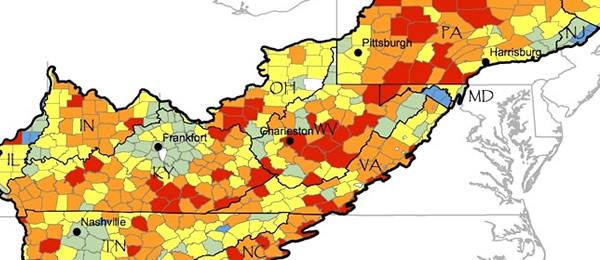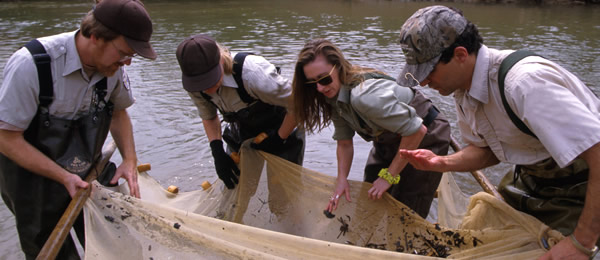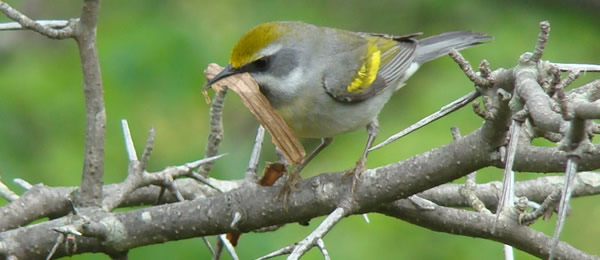Operational Plan

SECTION 1:Biodiversity and Conservation Challenges across the Appalachian Community
An introduction to the Appalachian region.

SECTION 2: Science Capacity within the Appalachian Community
Advancements in data integration across agencies, scientific and technological disciplines, and geographic and political boundaries. These include geospatial data, such as water quantity and quality, soils, vegetative cover and land use, invasive species distributions, and trends of native animal and plant populations.

SECTION 3: Management Capacity within the Appalachian Community
Federal, state and tribal organizations.

SECTION 4: Cooperative Governance and Decision-making
This governance charter authorizes the Appalachian LCC Steering Committee to provide operational oversight to make programmatic, policy, and funding decisions.

SECTION 5: Conservation Priorities Science Needs
Researchers and managers representing a diverse cross-section of expertise and affiliations contributed to identifying the science information needs of Appalachia in order to effectively address the conservation challenges and opportunities across the landscape.

SECTION 6: Operations - 5-Year Work Plan
This report represents the result of the Cooperative Steering Committee and Key Partners to produce a collaborative, integrated, and science-driven 5-Year Work Plan.
Table of Contents
Section 1.
Biodiversity and Conservation Challenges Across the Appalachian Region
Introduction to the Appalachian Region
- Land Use in the Appalachians
- Agriculture and Forestry
- Urbanization
- Energy Opportunities and Challenges
- Climate Change
- Highly Sensitive or Vulnerable Habitats and Species
- Appalachian LCC as a Climate Refugia and Continental-scale Connectivity Corridor
- Federal Conservation Agencies and Climate Change
- State Agencies and Climate Change Planning
- Protected Conservation Lands in Appalachian LCC
The Appalachian LCC - First Annual Report 2011: Commitment to Address the Challenge
Section 2:
Science Capacity within the Appalachian Community Federal Departments/Agencies
Science Capacities within DOI
- Science Capacities within Dept. of Commerce:
- Science Capacities within Department of Agriculture:
- Forest Service Research and Development
- Agricultural Research Service Centers
- Appalachian Farming Systems Research Center (Beaver, West Virginia)
- National Center for Cool and Cold Water Aquaculture (Leetown, West Virginia)
- Pasture Systems and Watershed Management Research Unit (University Park, Pennsylvania)
- North Appalachian Experimental Watershed (Coshocton, Ohio)
Regional Collaborative Science Partnerships or Initiatives
Section 3.
MANAGEMENT CAPACITY WITHIN THE APPALACHIAN COMMUNITY
Federal Agencies
- Fish and Wildlife Service, Department of Interior
- National Park Service, Department of Interior
- Office of Surface Mining Reclaimation and Enforcement, Department of Interior
- National Forest Service, Department of Agriculture
- Army Corps of Engineers, Department of Defense
- Tennessee Valley Authority
Partial List of Government Funding Sources to Support Appalachian LCC Activities
State Agencies
Tribes and Tribal Organizations
Non-Governmental Conservation Organizations
Public-Private Partnerships
- Appalachian Mountains (Bird) Joint Venture
- Central Hardwoods (Bird) Joint Venture
- Eastern Brook Trout Joint Venture (Fish Habitat Partnership)
- Southeast Aquatic Resources Partnership
- Ohio River Basin Fish Habitat Partnership (ORBFHP)
- Atlantic Coastal Fish Habitat Partnership
- Partners in Amphibian and Reptile Conservation
- Mid-Atlantic Highlands Action Program
- Appalachian Fire Learning Network
- Southern Blue Ridge Fire Learning Network
- Central Appalachian Spruce Restoration Initiative
Illustrative Case Study - Clinch Powell River Initiative
Section 4.
Cooperative Governance and Decision-making
Section 5.
Conservation Priorities Science Needs
- Background Resource Materials
- Science Needs Workshop (Nov 2011)
- Science Needs Portfolio (2012)
- Science Needs Portfolio (2013)
Funded Projects
Section 6.
Operations - 5-Year Work Plan
- Introduction - Section A
- Section B - Detailed Work Plan - by Goal, Objective, and Tasks
- Goal 1: Create and deliver a landscape-level data sharing strategy and scalable toolsets
- Goal 2: Deliver landscape-level conservation plans for regional use
- Goal 3: Create an on-going facilitated process to promote engagement and dialogue across the Appalachian LCC region
- Goal 4: Assess and align conservation goals and actions that reflect our Cooperative Members’ common and shared vision
- Section C - Staff Review of Near-term Tasks
- Glossary and Terms
Appendicies
- Appendix 1. Federally Listed, Proposed and Candidate Species; Priority Migratory Birds; and Interjurisdictional Fishes Occurring
- Appendix 2a. Federal Recovery Plans
- Appendix 2b. National Lead on Federally-listed Species
- Appendix 3. Species of Greatest Concern - Listed in State Wildlife Action Plans (includes species beyond AppLCC boundary.)
- Appendix 4. List of Universities participating in CESU Agreements across the AppLCC region






















